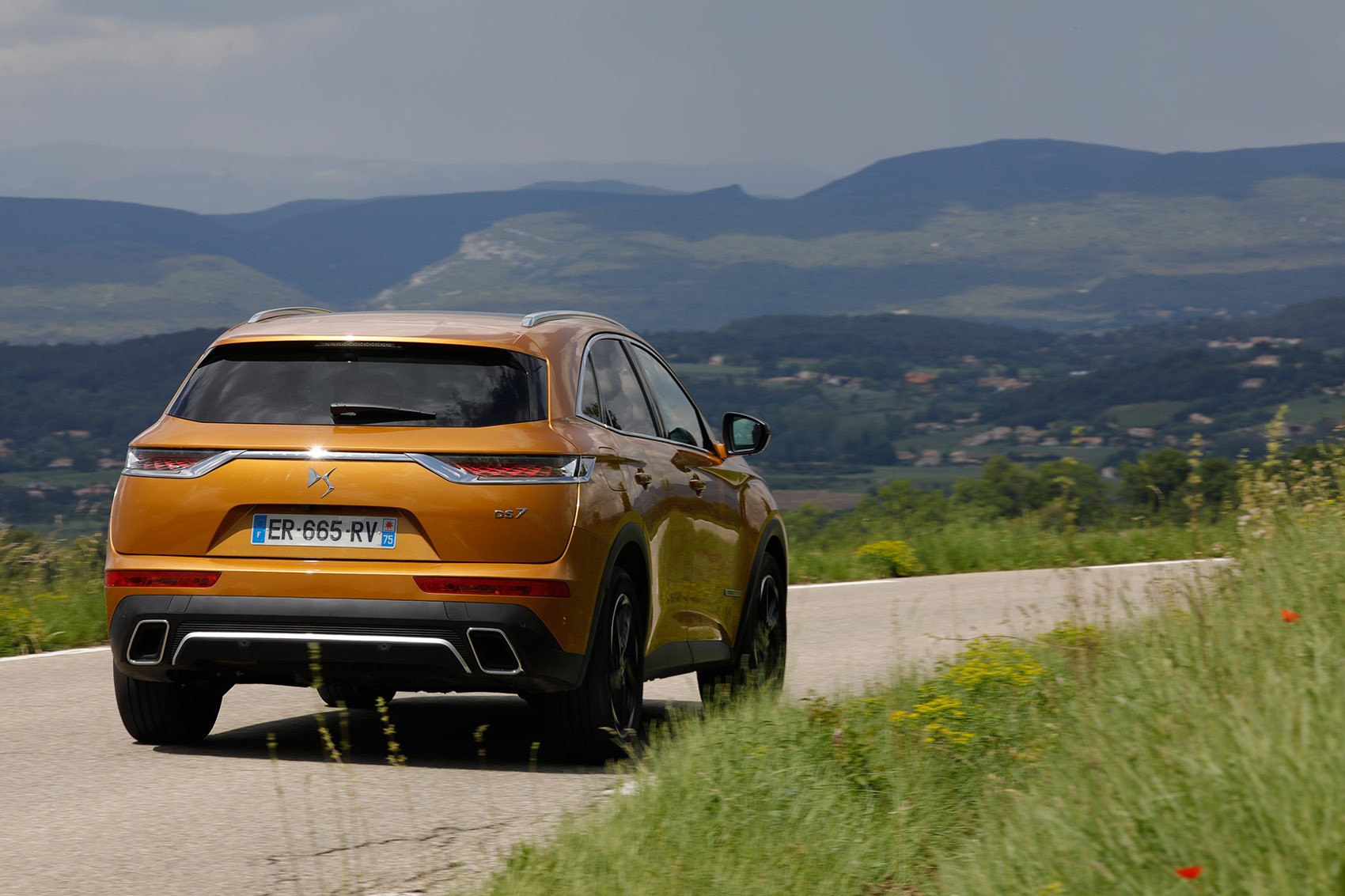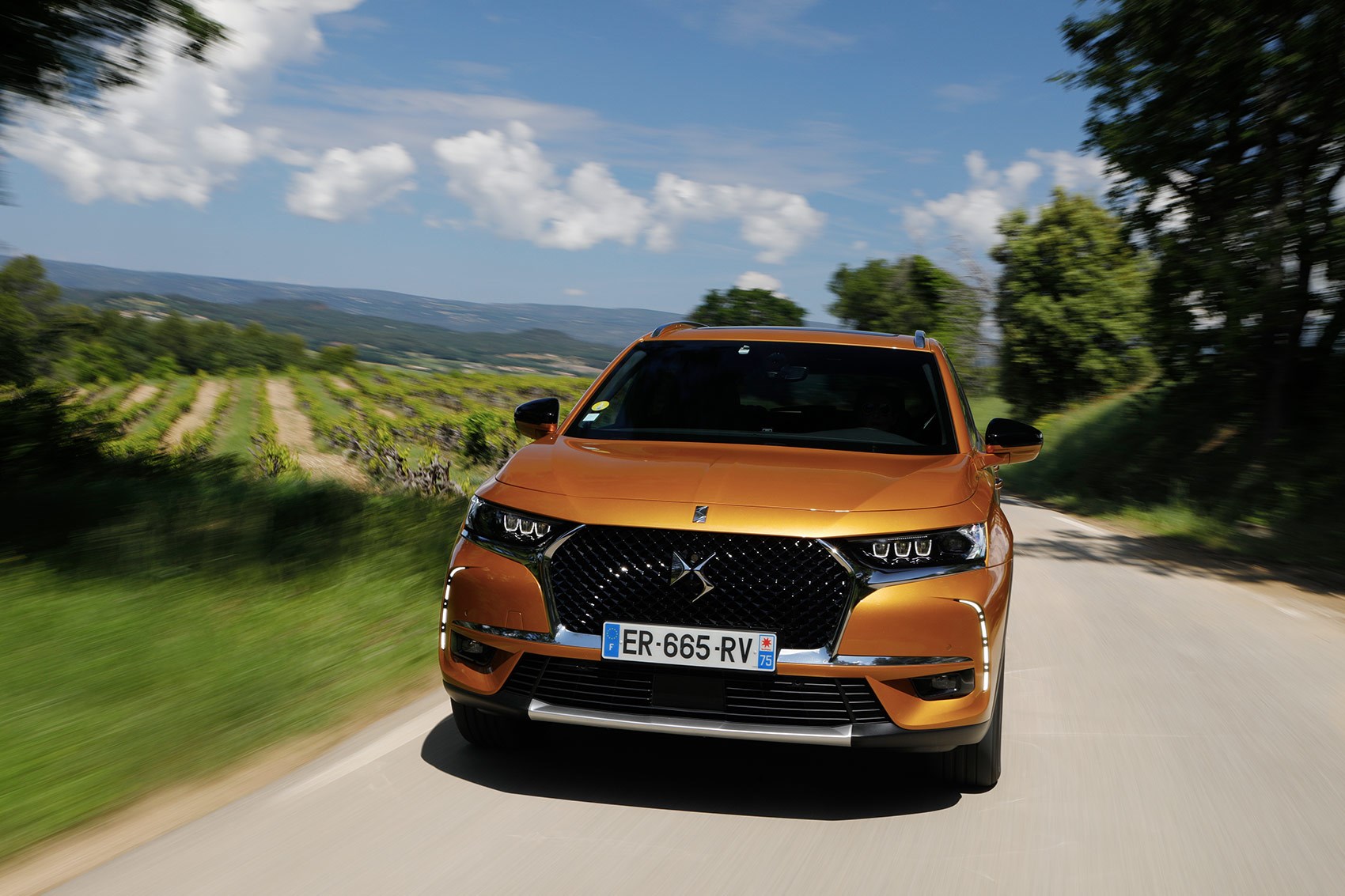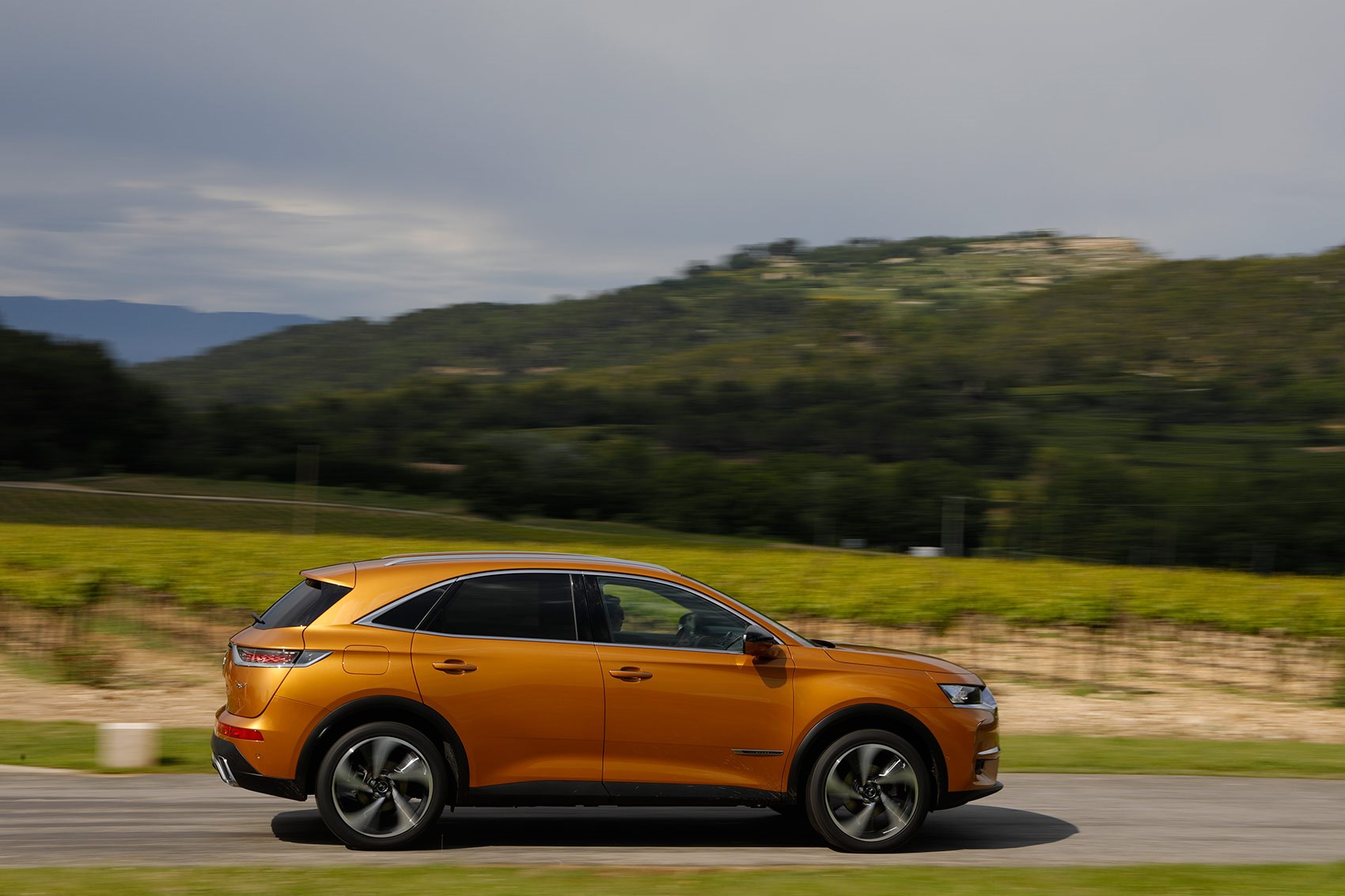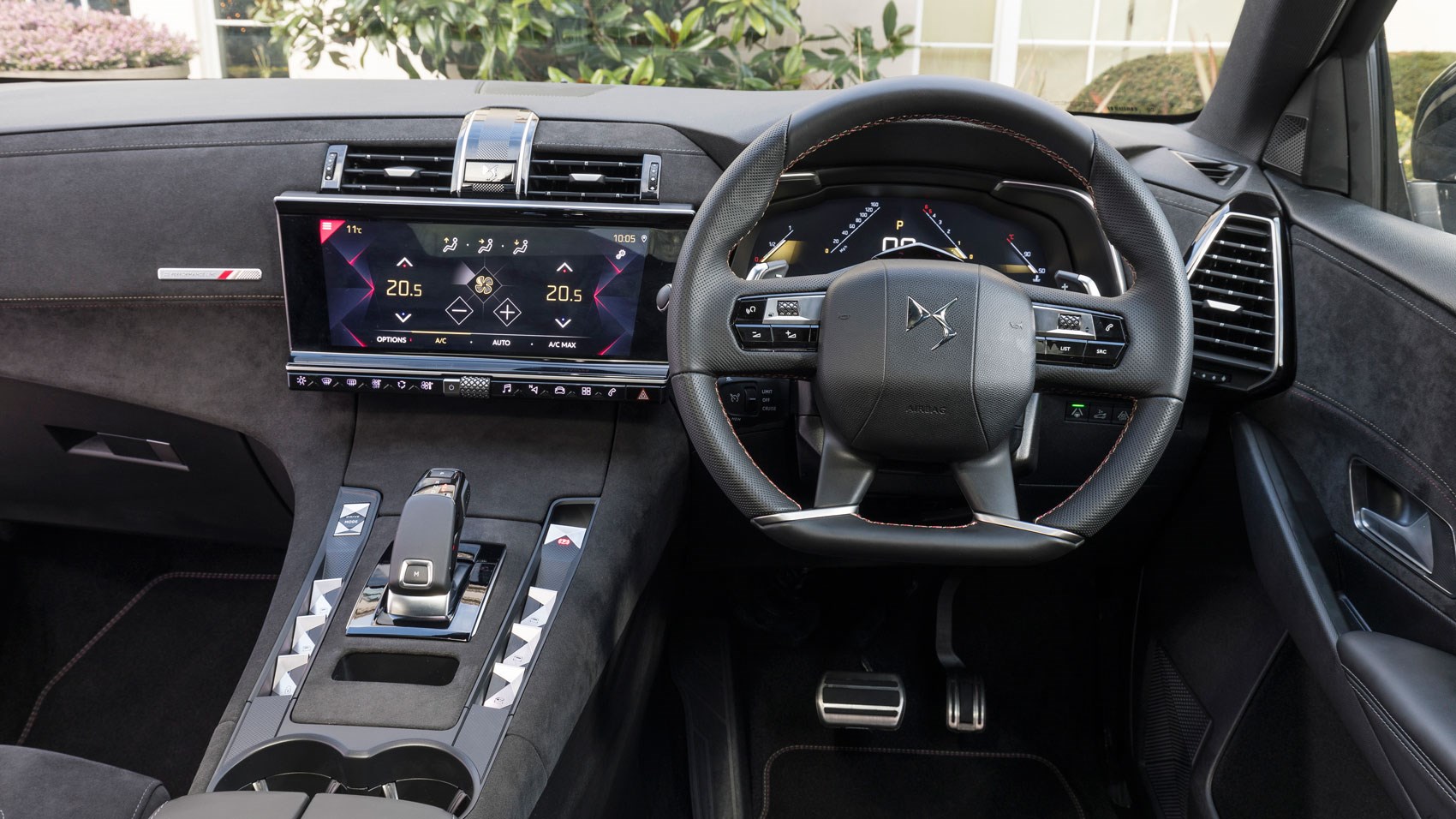► Punchy petrol DS7 tested
► More refined than the diesels…
► But does it make it a convincing package?
Plumping for a DS7 Crossback is evidence that you’re the kind of person who likes to make a statement, particularly if you’re funnelling 43 big ones into a top-flight Ultra Prestige example.
But, other than a desire not to follow the herd of premium SUV buyers clambering for a seat in one of the default Germanic triumvirate, it isn’t especially clear what message is being conveyed by this status proclamation in four-wheeled form.
Vive la différence, and all that, but the DS 7 needs to have substantial and tangible qualities to recommend it over an Audi Q3, BMW X1 or Mercedes GLA, as appealing as an abstract reason to buy one might be for some.
Perhaps the advent of a lusty 222bhp PureTech petrol engine will add lustre to the 7 Crossback’s appeal. Read on for our full review of the petrol DS7.
PureTech? Aren’t they the three-cylinder jobs?
Good spot! They were, but henceforth all petrol-engined PSA cars, regardless of the cylinder count, will carry the PureTech moniker, with diesels continuing to wear the BlueHDi label.

Going forth, there’ll be differentiation with electrified powertrains, typified by 2019’s DS 7 Crossback E-Tense being the PHEV version; Citroen, Peugeot and Vauxhall will all have their own electric nameplates.
Nestled under the DS 7’s semi-clamshell bonnet is an evolution of the familiar four-pot 1.6-litre turbocharged unit PSA originally developed with assistance from BMW, producing enough shove to squirt the Crossback from a standstill to 62mph in 8.2 seconds, topping out at 145mph.
Browse DS cars for sale
It feels brisk rather than rapid, but smooth progress is aided and abetted by the Aisin-supplied eight-speed automatic, directing the grunt exclusively to the front axle.
The powerplant never seems short of accelerative urge, making light work of overtaking manoeuvres, nor does it feel strained at the upper echelons of the rev range, although the engine note can sound a tad coarse at the top end.

Nevertheless, there’s a definite appeal to piloting a mid-sized SUV without a clattery diesel backing track, a fact highlighted by DS that the PureTech 225 – and its forthcoming, cheaper 177bhp alternative – are expected to account for a significant proportion of 7 Crossback sales in the UK.
As is de rigueur these days, a quartet of driving modes are on hand, with Sport proving the most responsive and sprightly. Unfortunately, this setting also means you have to endure piped rorty exhaust sounds through the Focal speaker system.
Sport? DSes of old were all about comfort…
This isn’t lost on PSA, highlighted by the standard fitment of Active Scan suspension on Prestige and Ultra Prestige 7 Crossbacks. Operational, appropriately enough, when Comfort mode is selected, the system monitors the road ahead and informs the dampers how to behave in order to deal with what’s about to be encountered beneath the wheels.
It sounds great, and similar systems on rival machinery works well, but here it lacks that ultimate degree of refinement.
Between 40-60mph feels like its sweet spot, where the DS rides with the cushioned, slightly floaty demeanour one might associate with French cars – it’s on point, and more importantly, on brand. However, beyond the confines of that narrow speed band, it’s less convincing.

At motorway speeds, although stable, it feels less controlled, tending to porpoise up and down over undulations, although bodyroll is kept in check. Those of a nauseous disposition might want to stock up on Kwells…
Around town, the serenity is broken by the crashy nature as it copes with ruts and ironworks, thumping over them with a lack of grace along the narrow, cobbled streets of the Provencal towns on our test route. Perhaps the scanners were distracted by the fleet of Facel Vegas we encountered en route…
Stick to models on sub-20-inch rims for better results. There’s only so much trick suspension can do to counter enormous alloy wheels and shallow tyrewalls, after all.
Still, there are some nice touches: the front seats are deeply cushioned and well-upholstered, while those in the back recline electrically. Taller passengers on the rear bench will be disappointed by the lack of foot room under the low-slung front chairs.
The DS 7’s interior looks upmarket, though
It does, and it remains PSA’s most premium interior, with no changes to the cabin to coincide with the introduction of the PureTech 225 engine. In Performance Line guise it’s particularly appealing, with Alcantara flocking many of the dashboard surfaces without descending into naffness.

Many of the surfaces feel appropriately squidgy and soft-touch, the functionality of the multimedia system is fine, with touch-sensitive buttons in lieu of a BMW iDrive-style rotary set-up – although the sat-nav graphics look clunky compared with rivals’ systems, and the digital instrument display lacks the pin-sharp clarity of Audi’s Virtual Cockpit.
While it’s broadly good, some areas still smack of centime-pinching: it’s great to see unique, DS-specific switchgear in the 7 Crossback, but a pity to find the various silver-finish surfaces feel tepid and plastic, rather than cold and metallic.
DS 7 Crossback PureTech 225: verdict
So are we any closer to discovering a compelling reason to go for a 7 Crossback in the face of a talented array of opponents? Not really.
In spite of the performance increase, it’s not satingly sporty, nor does it truly soothe and cosset its passengers either. And sure, while the cabin looks upscale, some tactile touch points are unsatisfying – Armani with a dash of Army Surplus.
What is clear, is that the least expensive Performance Line trim is the best flavour for the PureTech 225 DS7, not least because it looks more contemporary with satin grey trims in places of the tszujed-up chrome bling on the Prestige versions.
Perhaps for those considering a DS7, la différence is all the differentiation they need.
Read on for our review of the diesel DS 7 by Phil McNamara

► DS7 Crossback SUV driven
► Sporty Performance Line spec
► On sale February 2018
The DS7 Crossback is the first ‘proper’ all-new model from French luxury car brand DS Automobiles. Unlike its DS3, DS4 and DS5 siblings, the DS7 didn’t start out in life as a Citroen and retrospectively gain its premium veneer. No, it was designed from the ground up to be the first of six new models launched each year from 2018 onwards.
With this in mind, it’s almost certainly DS’s most important model yet, offering up a clear direction of where PSA’s premium arm is heading over this crucial period of the brand’s history. And by diving headfirst into the premium SUV pool, DS has positioned the DS7 in one of the fastest growing automotive markets around. Has the gamble paid off? Read on to find out…
The cockpit: France showcases its craftsmanship
Up front, rationality makes way for the avant-garde design you’d expect of the French: DS’s calling is to give to car buyers what French luxury brands Louis Vuitton and Chanel give to oligarchs’ girlfriends.
Angled switches cascade along the centre console like toppling dominoes, the side air vents are pyramidal with a studded finish, there’s a ghastly revolving clock from French horologists BRM and the volume dial is a small barrel of Swarovski-style crystal. It wobbles in its housing and is somewhat imprecise to use, but design insisted on it. That’s one of myriad reasons why this cockpit will never be mistaken for an Audi’s: vive la différence!

Climb into the trad-SUV elevated seating position, and your posterior immediately warms to the plump seats – they’re like being spooned by Bibendum, though could do with more lateral support. Imagine grasping a leather-trimmed wine bottle: that’s how thick the steering rim feels.
The materials are opulent: even the flap hiding a cubby in the centre console can be trimmed in Alcantara or leather. One stitch pattern, with a raised ball of thread reminiscent of a pearl, took two years to industrialise – though it’s still not perfectly spaced out.
It reads the road and adjusts ride comfort…
Craftsmanship is central to DS’s appeal, and so is comfort and technology. Top spec 180PS BlueHDI diesel or 225PS petrol engines are equipped with Active Scan technology, where a camera peers 5-10m down the road, assessing the topography and adapting the dampers accordingly. It noticeably softens the abruptness of your initial speed bump contact, before stiffening as you descend to control body pitching.
Strange, then, that after clearly investing large sums of money DS has only made the Active Scan function available with the suspension in Comfort mode. Switch to Sport or even Normal, and it’s automatically switched off.

However, even with it on the ride still isn’t up there with efforts from a number of the DS7’s rivals, struggling to match the levels of poise and maturity offered up by alternatives from Germany and Sweden with the Volvo XC40.
Decent performance, disappointing refinement
The 178bhp diesel engine, though responsive and adequately punchy (it doesn’t feel as sedate as 0-62mph in 9.9sec suggests), accelerates with a grumble of revs, and cruises with a persistent drone.
Higher fuel injection pressure to meet the latest emissions regulations is partly responsible for the increase in noise when cruising, plus DS has made the peculiar decision to pump synthesised engine sounds into car when Sport mode is activated. The side mirrors also produce noticeable wind noise at motorway speeds: the engineers are working on a foam insulation fix.
The eight-speed automated transmission is smooth and unobtrusive: a six-speed manual can be paired to the entry-level engines, a 128bhp 1.5-litre diesel, and a 1.2-litre three-cylinder petrol due in late 2018. Those driving the former will have to put up with a lacklustre turn of speed (0-62mph taking 10.8 seconds), but keep it below 4,000rpm (it which point the noise levels erupt) and it’s a usable powerplant.

Like all PSA gearboxes, the six-speed manual is not the last word in feel and quality of action not suited to hurried shifts between ratios, but it’s easy to use and drivers shouldn’t have any trouble finding the right gear.
The front-wheel drive chassis summons sufficient grip, but there’s a bit of dad-dancing about the electric motor-assisted steering: awkward elasticated responses that don’t always feel perfectly in time with the wheels, and some inconsistent weighting under load.
DS7 Crossback: packed with technology
But this is a car to cruise in, not fling at corners. And in addition to the cushy ride, the DS7 has more technological tricks in its armoury. Night Vision costs from £1100 to £1600, and an infra-red view of the road ahead can be displayed in varying sizes in the digital instrument panel – helpful for keeping eyes on the road and on any lurking animals.
Impressively, the technology has been programmed to display a degree of common sense. Pedestrians walking on the pavement will be highlighted by the car, yet the full on code black alerts are saved for animals on the side of the road – the idea, at least, being that they’re more likely to suddenly dash out in front of a car than their human counterparts.

And yet, all this may be superfluous maybe, thanks to the Active LED Vision motorised headlamps (standard on Performance Line models onwards) that widen or lengthen the beam depending on the type of road (determined by the car’s speed and steering angle). This nod to the original DS’s swivelling lamps splendidly illuminates country road verges and appropriately deploys high beam on your behalf.
Then there’s the effective Connected Pilot cruise control (£650) which accelerates, brakes and keeps the car in lane, precisely centred is the DS USP. Disappointingly, while the technology worked nicely when we drove the car in Europe, the lane guidance element didn’t find UK roads quite so easy to understand. Instead of guiding the car smoothly within the lane, the system bounced the DS7 in-between the two white lines, giving the alarming impression of a driver dosed up on too much Cointreau.
Verdict
In isolation the DS7 Crossback is a quirky, stylish choice for buyers in the premium SUV market. The technology on offer is undoubtedly impressive, and the efforts made to make the car feel different and unique should be celebrated. Whether it’s enough to make DS’s debut album (instead of all of those covers) a success remains to be seen, however there are significant obstacles in the way.
For example, PSA doesn’t appear to have quite mastered the art of differentiating the quality of its products across its range of manufacturers. By this, we mean that while the DS7 is certainly different, it struggles to feel noticeably more premium than ‘lesser’ models such as the Peugeot 3008.
It’s cars such as this that the DS7 will struggle against on car finance, too, with alternatives from Audi, Range Rover and Volvo all representing arguably better value when payments are spread over a number of years. The price for being different, it seems, has never been higher.
By Phil McNamara
Check out our DS car reviews